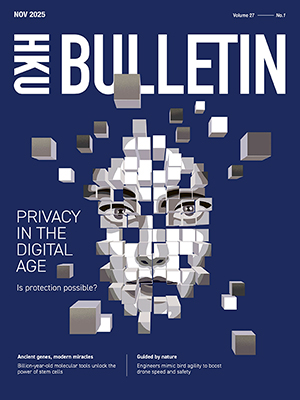November 2022 | Volume 24 No. 1
Be Prepared
Dr Mingzhu Tai and Professor Chen Lin, Stelux Professor in Finance, from the HKU Business School, were particularly interested in the mechanisms that were driving the increase in deposits during the pandemic and, for their study entitled ‘How Did Depositors Respond to COVID-19?’’, analysed vast resources of data to find out what the thinking was behind people’s actions.
“In the spring of 2020 when COVID-19 broke out globally, we were keeping close track on how the pandemic was impacting our economy and how policymakers in each country responded to it,” said Dr Tai. “In particular, we noticed that deposits and household savings increased dramatically starting from March and April of that year. Since deposits and household savings play a crucial role in our macroeconomy and financial system, especially during economic hardship, we decided that we should investigate what drove this surge in deposits and try to understand what we could learn from it regarding its economic and policy implications.”
Dr Tai and Professor Lin, working in collaboration with the University of California, Berkeley and the Chinese University of Hong Kong, examined five potential drivers in their research. The first was the ‘precautionary savings’ view – also known as Aesop’s credo, after the Greek fable writer’s philosophy “it is thrifty to prepare today for the wants of tomorrow” – whereby households saved more due to concerns about employment and income security triggered by the pandemic.
Professor Lin said: “The testable predictions associated with this view propose that local COVID-19 infection rates had a positive relationship with local concerns about future job losses and income, a positive association with increases in local bank deposits, and a negative relationship with the local deposit interest rates.”
The second possible driver was the ‘flight-to-safety’ theory which stresses that individuals reallocated part of their savings into bank deposits and other safer investments to avoid the financial disruptions triggered by the pandemic. “It predicts that infection rates would have had a stronger negative effect on local deposit interest rates among safer banks and a positive impact on insured deposits,” said Dr Tai.
Third, the ‘drawdown-and-deposit’ view starts by noting that firms, having made large withdrawals from their lines of credit, would have then deposited this money into banks. “This view proposes a positive relationship between county-level infection rates and local bank deposits by firms; a negative relationship between infection rates and deposit rates; and no connection between infection rates and deposit rates when firms did not draw down their credit lines,” said Professor Lin.
Fourth, the ‘demand-for-deposits’ view, proposes that the banks themselves may have attracted funds by raising deposit rates and cutting new lending – a notion which implies that local infection rates will be positively related to local deposit rates.
Finally, fifth was the ‘policy response to the pandemic’ view. “This view suggests that the US government’s economic policies enacted in response to the pandemic – the Coronavirus Aid, Relief, and Economic Security Act and the Paycheck Protection Program – were responsible for the increased deposits, since more federal funding was given to counties with higher COVID-19 infection rates,” said Professor Lin. “Thus, the view goes, the more local infections, the higher the local deposits.”
Precautionary savings mechanism
“Our empirical findings support in particular the precautionary savings mechanism,” said Dr Tai. “Our analysis found that local COVID-19 infection rates were positively associated with intensified anxieties about future job losses, increased expectations of future income losses and a concurrent reduction in spending due to these expectations. Infection rates were also positively associated with a boom in local bank deposits, especially retail deposits, and declines in the interest rates offered on local deposits – each of the testable questions received a solid ‘yes’.”
“Human factors turned out to be the key to answering the question,” said Professor Lin. “Anxiety really does galvanise people into action.”
Regarding the other four potential drivers under consideration, none of them were supported or confirmed.
“The ‘flight-to-safety’ view was not supported because the study did not find that local infection rates were associated with a larger reduction in local deposit interest rates or a larger increase in insured deposits,” said Professor Lin. “Nor was the ‘drawdown-and-deposit’ view confirmed because no weaker connections between county-level exposure to COVID-19 and deposit rates were found, nor were there any larger increases in wholesale business deposits relative to retail banking deposits.”
“Findings on the ‘demand-for-deposits’ view were inconsistent, as COVID-19 infection rates were associated with material declines in deposit rates, rather than increases,” said Dr Tai. “This negative relationship between deposit interest rates and infection rates also indicated that neither national- nor state-level macroeconomic policy had any causative effect, which meant the policy response perspective was also unsupported.”
Our analysis found that local COVID-19 infection rates were positively associated with intensified anxieties about future job losses, increased expectations of future income losses and a concurrent reduction in spending due to these expectations.

DR MINGZHU TAI

